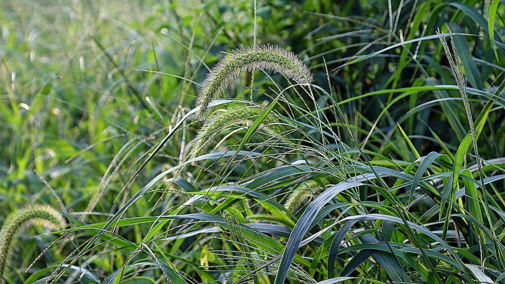Selecting Summer Annual Forages
It is close to the ideal time to plant a summer annual grass, maybe to replenish your hay supply or have some extra grazing. Which one will you plant?
Choosing a summer forage can be confusing because there are about seven different types of major summer annual forage grasses. These include: sudangrass, sorghum-sudan hybrids, forage sorghum (which we often call cane or sorgo), foxtail millet, pearl millet, Japanese millet and teff. Each one has its own strengths and weaknesses. So, base your choice primarily on how you plan to use it.
For example, do you want pasture? Then use sudangrass or pearl millet. Both are leafy, regrow rapidly and contain less danger from prussic acid poisoning than other annual grasses.
What if you want hay or green chop? Then select sorghum-sudan hybrids or pearl millet because they yield well and they have good feed value when cut two or three times.
On sandy soils, or when conditions are dry, foxtail millet may be a better choice for summer hay. It dries fast, doesn't regrow after cutting and handles dry soils well.
Cane hay is grown in many areas and produces high tonnage, but it’s lower in feed value and dries more slowly after cutting than the hybrids or millets.
Japanese millet can either be cut for hay or grazed and is a plant that can tolerate heavy, wet soils.
Choose teff if you are looking for a really soft, leafy, high quality horse hay.
Maybe you plan to chop silage. Then choose the forage sorghums, especially hybrids with high grain production. They can't be beat for tonnage or for feed value.
While there are several choices of summer annual forages, simply select the one that is best adapted to the way you plan to use it. And, of course, hope for rain, since even these grasses won’t grow without some moisture.
Wheatlage Management
Cereal grain crops, including rye, triticale and oats can be harvested as forage silage and wheat as wheatlage. Compared to traditional haying, spring silage systems provide earlier forage harvesting with higher moisture content. This allows quicker double-crop planting to extend growth for subsequent corn or forage sorghum silage fall harvest within same fields.
UNL research indicates that waiting until cereal crops reach the soft dough grain development stage may offer the optimum silage harvest timing to maintain up to 12 tons per acre of forage production with 15% to 20% crude protein and 69% TDN (total digestible nutrients) content for lactating beef and dairy. Delaying the cereal crop silage harvest until the hard dough heading stages may still maintain 10% crude protein and 60% TDN while increasing forage tonnage up to 20 tons per acre.
The target cutting moisture content for cereal crop silage is 67% to properly ferment to 30-35% dry matter. If the moisture content drops below 67%, then the silage may be too fluffy to adequately pack properly, allowing oxidizing butyric acid to raise spoilage. Thus, increasing nutrient losses and lowering palatability. Conversely, when silage is too wet (above 78% moisture) fermentation can result in slimy silage, where the butyric acid bacteria start taking over, causing higher TDN losses as moisture drains from the pile.
Rye with hollow stems may be harder to pack, especially when higher stem to leaves ratios increase in later development compared to wheat. Smaller forage chopping size can increase bulk density and improve silage packing but also causes harvest equipment to use more fuel. Acknowledging that dairy producers prefer longer chopped forages for increased fiber content.
Grasshopper Management
The 2025 rangeland grasshopper risk map from the USDA indicates there may be increased grasshopper activity in the eastern panhandle and southwestern Nebraska. Keeping an eye on fields this spring and summer can help mitigate economic loss from grasshopper feeding.
Grasshoppers tend to thrive in dry, hot conditions, while outbreaks can be severely limited by cool, wet spring weather; however, it is still recommended that producers throughout the state scout their fields while grasshoppers are in the nymph stage and therefore easier to control. Degree-day models estimate that current grasshopper populations are still in the nymph stage, making this the best time to control populations that are nearing or above threshold.
One of the best ways to scout for grasshoppers is to use the square foot method. Randomly select an area several feet away and visualize a one square-foot area around that spot. Walk toward this spot and count the number of grasshoppers you see in or jumping out of this area. Repeat this procedure 18 times and divide the total number of grasshoppers by two. This will give you the number of grasshoppers per square yard. Economic thresholds for grasshoppers range from eight to 40 grasshoppers per square yard, depending on a variety of factors. Keep in mind that control is generally recommended before grasshoppers reach maturity.
For current insecticide recommendations for controlling grasshoppers in rangeland, forages, alfalfa and other crops, please contact your county extension office.

